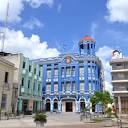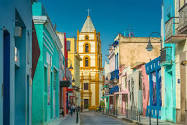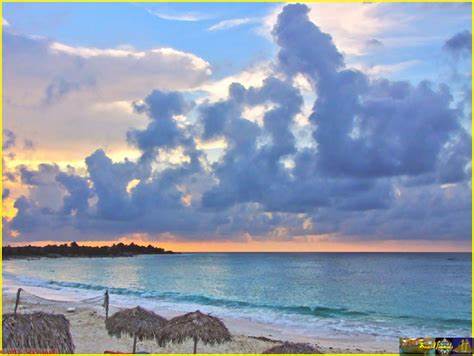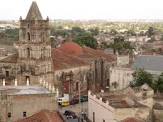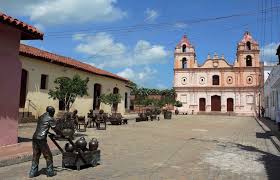CAMAGUEY, CUBA: LA TERCERA MAYOR Y PRINCIPAL PROVINCIA GANADERA DE CUBA. PHOTOS.
Camagüey es la provincia más oriental del centro de Cuba, la de mayor área y la más llana. Antes de la actual división político-administrativa incluía los territorios de las provincias de Ciego de Ávila, parte de Sancti Spíritus y Las Tunas.
La provincia se sitúa entre los 20° 31’ 01” ―Faro Cabeza del Este― y los 22° 29’ 00” ―Faro Paredón Grande― de latitud norte y los 76° 57’ 00” de longitud oeste del meridiano de Greenwich, limita al norte con el Canal Viejo de Bahamas, y al sur con el mar Caribe, al este con la provincia de Las Tunas y al oeste con la provincia de Ciego de Ávila. Es la mayor provincia de Cuba y la más llana, con una superficie total de 15386,16 km², ocupando el 14,0% del territorio nacional. El área de tierra firme es de 14152.20 km² y de los cayos adyacentes es de 1233.96 km².
En la parte norte se encuentra el archipiélago de Camagüey: Cayo Romano ―el mayor del país―, Cayo Guajaba y Cayo Sabinal.
En la parte sur se localizan los cayos Jardines de la Reina. La principal bahía está situada en el municipio de Nuevitas.
La provincia posee el 25 % de todas las playas del país con aproximadamente 120 km y cuenta además con la segunda mayor barrera coralina en el mundo.
DEMOGRAFIA Y POBLACION
Se divide en 13 municipios de los cuales la ciudad de Camagüey es la cabecera, dividida a su vez en cuatro distritos.
Municipios
Carlos Manuel de Céspedes, Esmeralda, Sierra de Cubitas, Minas, Nuevitas, Guáimaro, Sibanicú, Camagüey, Florida, Vertientes, Jimaguayú, Najasa, Santa Cruz del Sur.
Población
La población general de la provincia asciende a más de 772.201 habitantes con una densidad poblacional de 50.2 hab/km², en la ciudad de Camagüey asciende a 329195 habitantes. Teniendo en cuenta la base económica de la provincia, que es eminentemente agropecuaria, se considera baja la densidad y alto el grado de urbanización, ya que sólo el 25 % de la población vive en áreas rurales.
ECONOMIA
Alrededor de 125 kilómetros de playa de excepcional calidad localizados en el balneario de Santa Lucía y un grupo de cayos adyacentes, entre los que destacan Cayo Sabinal, Cayo Romano y Cayo Cruz, constituyen el principal y más conocido atractivo turístico de Camagüey, provincia extendida sobre 15 900 kilómetros cuadrados en la porción centro-oriental del archipiélago cubano y que tradicionalmente ha tenido en la ganadería y la industria azucarera los dos principales sostenes de su desarrollo económico. Sin embargo el turismo está muy pobremente explotado, aunque cuenta con toda la infraestructura básica en la zona de Santa Lucía. A partir del 2011, han comenzado a desarrollarse planes y labores para construir en la zona de la cayería norte de la provincia, específicamente en los cayos Romano y Sabinal, más de 25 000 habitaciones de turismo.
Asi mismo, la provincia cuenta con poderosas industrias, como la central termoeléctrica Diez de Octubre, la fábrica de cemento 26 de Julio, la fábrica de fertilizantes Revolución de Octubre en la ciudad de Nuevitas, y numerosas empresas de materiales de la construcción, tanto de producción de cemento como de elementos de piso y prefabricado, hasta canteras. Asi mismo importantes empresas de la rama metal-mecánica, como la Planta Mecánica Ignacio Agramonte y Loynaz, o la de reparación de motores José Smith Comas. Camagüey posee además importantes talleres ferroviarios.
Existen además importantes potencialidades de la industria minera, a través de los no explotados yacimientos de níquel de San Felipe, cercanos a la ciudad de Camagüey, y la mina de oro de San Jacinto, en Guáimaro, además de otras minas de cromo, feldespato, manganeso, y la Salina de El Real, en la playa Santa Lucía.
Otro puntal importante en la economía camagüeyana es la industria alimentaria, con factorías destinadas al procesamiento de la producción láctea, el combinado cárnico y la fábrica de cervezas Tínima, que elabora la cerveza del mismo nombre, famosa a nivel nacional. Está en construcción una fábrica de leche en polvo en la ciudad de Camagüey, que producirá diariamente unas 6 toneladas de leche en polvo.
La industria azucarera actualmente comprende 5 centrales azucareros, dos de ellos refinerías. Camagüey produce el 13 % del azúcar cubano.
Camagüey continúa siendo la principal provincia ganadera cubana, con una masa estimada de más de 68853 cabezas de ganado. Posee también importantes empresas de crianza equina y bufalina.
Los alimentos y la leche elaborados en Camagüey son utilizados para abastecer a provincias aledañas que no cuentan con dichos recursos. La provincia produce el 25 % de la leche vacuna del país.
Importante es también la existencia de instituciones científicas vinculadas a la producción, como el Centro de Ingeniería Genética y Biotecnología de Camagüey, cuyas producciones van destinadas fundamentalmente a la esfera agrícola y pecuaria.
El partido Comunista, unico partido permitido en Cuba, tiene como Gobernadora de la provincia a Yoseily Góngora López.
DEPORTES
La provincia de Camagüey ha sido la cuna de diversos campeones y subcampeones olímpicos, como Filiberto Azcuy (lucha libre), Luis Ulacia Alvarez (béisbol),Yumilka Ruiz y Mireya Luis (voleibol), Yipsi Moreno (lanzamiento de martillo). Tiene equipos provinciales en todos los campeonatos nacionales, destacando el Boxeo, la Lucha libre, el Voleibol femenino, el Fútbol, el Baloncesto, y atletas destacados en los deportes de remo, y salto de plataforma. Cuenta con numerosas instalaciones deportivas, entre las que destacan la Sala Polivalente “Rafael Fortún”, y de béisbol Estadio Cándido González.
Esta provincia ha tenido la iniciativa de declarar Familias Panamericanas a las casas de los familiares de los deportistas que participarán en los Juegos Panamericanos Guadalajara 2011, que se desarrollaron del 14 de octubre al 30 de octubre en México.
El equipo camagüeyano de boxeo conquistó en el 2015 su quinto título consecutivo de campeón del Torneo Playa Girón, máxima competición del boxeo cubano.
LUGARES DE INTERES HISTORICO Y CULTURAL..
El Callejón Funda del Catre, llamado popularmente así porque según los vecinos del lugar no permitía el tránsito de dos caballos juntos; la Plaza de San Juan de Dios y Plaza del Carmen; el Convento de las Madres Ursulinas; las Cinco esquinas del Ángel; el Aguador del ferrocarril; o la Iglesia de Nuestra Señora del Carmen, Iglesia Nuestra Señora de la Merced, la Iglesia Santa Ana, la Iglesia Parroquial Mayor, las Parroquia de Nuestra Señora de la Soledad y la Parroquia de Nuestra Señora de la Caridad, o la Iglesia del Sagrado Corazón de Jesús, son puntos del entramado urbano camagüeyano de mucho interés para el visitante.
Como lo son también las Casa natal de Ignacio Agramonte, héroe de la primera gesta independentista; del Poeta Nacional, Nicolás Guillén; del eminente científico Carlos J. Finlay, y de las poetisas Gertrudis Gómez de Avellaneda y Aurelia Castillo; así como el Teatro Principal, sede del afamado Ballet de Camagüey, fundado en 1967, y de la Orquesta Sinfónica Provincial en 1961; o el parque Casino Campestre, el mayor de los parques construidos dentro de una ciudad cubana.
Visitar Camaguey representa la posibilidad de disfrutar del San Juan Camagüeyano, una fiesta popular surgida entre 1725 y 1728 y que hoy se celebra entre los días 24 y 29 de junio; degustar platos típicos de la cocina local como el Ajiaco camagüeyano, el tasajo o la montería; o acercarse al quehacer de una joven generación de talentosos ceramistas para conocer, de primera mano, una ciudad considerada como un importante centro cultural y científico de la nación y donde nació, en el siglo XVI, la primera obra literaria cubana, Espejo de Paciencia, una creación del escribano del cabildo Silvestre de Balboa.
OTROS LUGARES DE INTERES
Plaza de Maceo (Camagüey)
Plaza de la Juventud (Camagüey)
Plaza de la Revolución (Camagüey)
Plaza de la Solidaridad (Camagüey)
Plaza de los Trabajadores (Camagüey)
Plazuela de Bedoya (Camagüey)
Parque José Martí (Camagüey)
Plaza Antonio Maceo (Camagüey)
Parque Ignacio Agramonte (Camagüey)
Plaza del Carmen (Camagüey)
Plaza de San Juan de Dios
Parque El Cañón (Nuevitas)
Complejo Malecón Patana (Nuevitas)
Playa Santa Lucía (Nuevitas)
Parque José Marti (Florida)
Boulevard Florida (Florida)
Parque Constitución (Guaimaro)
Plaza Santa Cruz (Santa Cruz del Sur)
CAMAGUEY, CUBA: THIRD LARGEST AND THE MAIN LIVESTOCK PROVINCE OF CUBA. PHOTOS.
Camagüey is the easternmost province of central Cuba, the one with the largest area and the flattest. Before the current political-administrative division, it included the territories of the provinces of Ciego de Ávila, part of Sancti Spíritus, and Las Tunas.
The province is located between 20° 31′ 01” ―Faro Cabeza del Este― and 22° 29′ 00” ―Faro Paredón Grande― north latitude and 76° 57′ 00” west longitude of the Greenwich meridian, It limits to the north with the Canal Viejo de Bahamas, and to the south with the Caribbean Sea, to the east with the province of Las Tunas and to the west with the province of Ciego de Ávila. It is the largest province in Cuba and the flattest, with a total area of 15,386.16 km², occupying 14.0% of the national territory. The area of the mainland is 14152.20 km² and that of the adjacent keys is 1233.96 km².
In the northern part is the Camagüey archipelago: Cayo Romano -the largest in the country-, Cayo Guajaba and Cayo Sabinal.
The Jardines de la Reina keys are located in the southern part. The main bay is located in the municipality of Nuevitas.
The province has 25% of all the beaches in the country with approximately 120 km and also has the second largest coral reef in the world.
DEMOGRAPHICS AND POPULATION
It is divided into 13 municipalities of which the city of Camagüey is the head, divided in turn into four districts.
Municipalities
Carlos Manuel de Céspedes, Esmeralda, Sierra de Cubitas, Minas, Nuevitas, Guáimaro, Sibanicú, Camagüey, Florida, Vertientes, Jimaguayú, Najasa, Santa Cruz del Sur.
Population
The general population of the province amounts to more than 772,201 inhabitants with a population density of 50.2 inhabitants/km², in the city of Camagüey it amounts to 329,195 inhabitants. Taking into account the economic base of the province, which is eminently agricultural, the density is considered low and the degree of urbanization high, since only 25% of the population lives in rural areas.
ECONOMY
Around 125 kilometers of beaches of exceptional quality located in the resort of Santa Lucía and a group of adjacent keys, among which Cayo Sabinal, Cayo Romano, and Cayo Cruz stand out, constitute the main and best-known tourist attraction of Camagüey, a province that extends over 15,900 square kilometers in the central-eastern portion of the Cuban archipelago and which has traditionally had cattle ranching and the sugar industry as the two main supports of its economic development. However, tourism is very poorly exploited, although it has all the basic infrastructure in the Santa Lucía area. As of 2011, plans and work have begun to be developed to build more than 25,000 tourist rooms in the area of the northern keys of the province, specifically in the Romano and Sabinal keys.
Likewise, the province has powerful industries, such as the Diez de Octubre thermoelectric plant, the July 26 cement factory, the October Revolution fertilizer factory in the city of Nuevitas, and numerous construction material companies, both from the production of cement as well as floor and prefabricated elements, even quarries. Likewise, important companies in the metal-mechanical branch, such as the Ignacio Agramonte and Loynaz Mechanical Plant, or the José Smith Comas engine repair plant. Camagüey also has important railway workshops.
There is also significant potential for the mining industry, through the unexploited nickel deposits of San Felipe, near the city of Camagüey, and the San Jacinto gold mine, in Guáimaro, in addition to other chrome, feldspar, manganese, and the Salina de El Real, on Santa Lucía beach.
Another important pillar in Camagüey’s economy is the food industry, with factories destined for the processing of dairy products, and combined meat, and the Tínima beer factory, which produces beer of the same name, is famous at the national level. A powdered milk factory is under construction in the city of Camagüey, which will produce about 6 tons of powdered milk daily.
The sugar industry currently comprises 5 sugar mills, two of their refineries. Camagüey produces 13% of Cuban sugar.
Camagüey continues to be the main Cuban cattle province, with an estimated mass of more than 68,853 head of cattle. It also owns important equine and buffalo breeding companies.
Food and milk made in Camagüey are used to supply neighboring provinces that do not have such resources. The province produces 25% of the country’s cow’s milk.
Also important is the existence of scientific institutions linked to production, such as the Center for Genetic Engineering and Biotechnology of Camagüey, whose productions are fundamentally destined for the agricultural and livestock sphere.
The Communist Party, the only party allowed in Cuba, has Yoseily Góngora López as Governor of the province.
SPORTS
The province of Camagüey has been the birthplace of various Olympic champions and runners-up, such as Filiberto Azcuy (wrestling), Luis Ulacia Alvarez (baseball), Yumilka Ruiz and Mireya Luis (volleyball), Yipsi Moreno (hammer throw). It has provincial teams in all the national championships, highlighting Boxing, Wrestling, Women’s Volleyball, Soccer, Basketball, and outstanding athletes in rowing and platform jumping. It has numerous sports facilities, among which the “Rafael Fortún” Multipurpose Hall and the Cándido González Baseball Stadium stand out.
This province has taken the initiative to declare Pan American Families to the homes of relatives of athletes who will participate in the Pan American Games Guadalajara 2011, which took place from October 14 to October 30 in Mexico.
In 2015, the Camagüey boxing team won its fifth consecutive title as champion of the Playa Girón Tournament, the highest competition in Cuban boxing.
PLACES OF HISTORICAL AND CULTURAL INTEREST…
The Funda del Catre Alley, popularly called that way because, according to local residents, it did not allow the transit of two horses together; the Plaza de San Juan de Dios and Plaza del Carmen; the Convent of the Ursuline Mothers; the Five Corners of the Angel; the Water Carrier of the railway; or the Church of Our Lady of Mount Carmel, Church of Our Lady of Mercy, Church of Santa Ana, Church of the Greater Parish, Parish of Our Lady of Solitude and Parish of Our Lady of Charity, or the Church of the Sacred Heart de Jesús, are points of the Camagüey´s urban framework of great interest for the visitor.
As are the Birthplace of Ignacio Agramonte, hero of the first independence struggle; of the National Poet, Nicolás Guillén; the eminent scientist Carlos J. Finlay, and the poets Gertrudis Gómez de Avellaneda and Aurelia Castillo; as well as the Teatro Principal, headquarters of the famous Camagüey Ballet, founded in 1967, and of the Provincial Symphony Orchestra in 1961; or the Casino Campestre park, the largest of the parks built within a Cuban city.
Visiting Camaguey represents the possibility of enjoying San Juan Camagüeyano, a popular festival that emerged between 1725 and 1728 and that today is celebrated between June 24 and 29; taste typical dishes of the local cuisine such as the Ajiaco from Camagüey, the jerky or the montería; or approach the work of a young generation of talented potters to get to know, first-hand, a city considered to be an important cultural and scientific center of the nation and where, in the 16th century, the first Cuban literary work, Espejo de Paciencia, was born. creation of the clerk of the Cabildo Silvestre de Balboa.
OTHER PLACES OF INTEREST
Maceo Square (Camagüey)
Youth Square (Camagüey)
Revolution Square (Camagüey)
Solidarity Square (Camagüey)
Workers Square (Camagüey)
Bedoya Square (Camagüey)
José Martí Park (Camagüey)
Antonio Maceo Square (Camagüey)
Ignacio Agramonte Park (Camagüey)
Plaza del Carmen (Camaguey)
Saint John of God Square
The Canyon Park (Nuevitas)
Malecon Patana Complex (Nuevitas)
Santa Lucia Beach (Nuevitas)
Jose Marti Park (Florida)
Boulevard Florida (Florida)
Constitution Park (Guaimaro)
Santa Cruz Square (Santa Cruz del Sur)
Agencies/ Wiki/ CamagueyHist./ Extractos/ Excerpts/ Internet Photos/ Arnoldo Varona/ www.TheCubanHistory.com
THE CUBAN HISTORY, HOLLYWOOD.



 CAMAGUEY, Cuba: La Tercera Mayor y Principal Provincia Ganadera de Cuba. PHOTOS. * CAMAGUEY, Cuba: Third Largest and the Main Livestock Province of Cuba. PHOTOS.
CAMAGUEY, Cuba: La Tercera Mayor y Principal Provincia Ganadera de Cuba. PHOTOS. * CAMAGUEY, Cuba: Third Largest and the Main Livestock Province of Cuba. PHOTOS.
